Belarus
| Place | Building | Main period of construction | Special features | Image |
| Mir | Mir Castle | 15th–16th century | Late 16th century additions to Gothic structure |  |
Brick Renaissance is the Northern European continuation of brick architecture after Brick Romanesque and Brick Gothic. Although the term Brick Gothic is often used generally for all of this architecture, especially in regard to the Hanseatic cities of the Baltic, the stylistic changes that led to the end of Gothic architecture did reach Northern Germany and northern Europe with delay, leading to the adoption of Renaissance elements into brick building. Nonetheless, it is very difficult for non-experts to distinguish transitional phases or early Brick Renaissance, as the style maintained many typical features of Brick Gothic, such as stepped gables. A clearer distinction only developed at the transition to Baroque architecture. In Lübeck, for example, Brick Renaissance is clearly recognisable in buildings equipped with terracotta reliefs by the artist Statius von Düren, who was also active at Schwerin (Schwerin Castle) and Wismar (Fürstenhof).
More clearly recognisable as Renaissance are brick buildings strongly influenced by the Dutch Renaissance style, such as Reinbek Castle at Reinbek near Hamburg, the Zeughaus at Lübeck, or Friedrichstadt in Schleswig-Holstein.
| Place | Building | Main period of construction | Special features | Image |
| Mir | Mir Castle | 15th–16th century | Late 16th century additions to Gothic structure |  |
| Place | Building | Main period of construction | Special features | Image |
| Copenhagen | Børsen | 1619–1640 | Dutch Renaissance style (architects Hans and Lorents van Steenwinckel) renaissance |  |
| Rosenborg Castle | 1606–1624 | Built in the Dutch Renaissance style by Architects Bertel Lange and Hans van Steenwinckel |  | |
| Hillerød | Frederiksborg Castle | 1602–1620 | Dutch Renaissance style (architects Hans and Lorents van Steenwinckel) |  |
| Place | Building | Main period of construction | Special features | Image |
| Friedrichstadt | Market Square | early 17th century | Plastered brick |  |
| Lübeck | Mühlentor | 1550s (model) |  | |
| Schiffergesellschaft | 1535–1538 |  | ||
| Zeughaus | 1594 |  | ||
| Reinbek | Castle | 1572–1576 |  | |
| Place | Building | Main period of construction | Special features | Image |
| Ferrara | Castello Estense | 1385–1450, early 16th century | The castle essentially presents the appearance given to it by Girolamo da Carpi in the second half of the 16th century |  |
| Milan | Castello Sforzesco | 14th century, 1450 |  | |
| Town/city | Building | Main period of construction | Special features | Image |
| Vytėnai | Panemunė Castle | 1604–1610 |  | |
| Raudondvaris | Raudondvaris Castle | 16th century, 1615 | Rebuilt 1653–1664 |  |
| Siesikai | Siesikai Castle | c. 1517 |  | |
| Jonava | St. Anne's Church in Skaruliai | c. 1622 |  | |
| Place | Building | Main period of construction | Special features | Image |
| Brochów | Fortified church | 1551–1561, 1596 | Gothic-renaissance church established by Jan Brochowski and his family as a three-nave church with three side towers |  |
| Bydgoszcz | Church of the Assumption of Mary | 1582–1645 |  | |
| Gdańsk | Green Gate | 1564–1568 | Example of the Flemish mannerism in the city inspired by the Antwerp City Hall (architect Regnier van Amsterdam) [1] |  |
| Old Arsenal | 1602–1605 | Built in Dutch/Flemish mannerism by Anthonis van Obbergen, Jan Strakowski and Abraham van den Blocke [2] |  | |
| Gołąb | Church of St. Catherine and St. Florian | 1628–1638 | Polish mannerism style |  |
| Grocholin | Fortified manor house | 16th century | Built for Wojciech Baranowski, is a rare example of defense housing architecture in northern Poland [3] |  |
| Piotrków Trybunalski | Royal Castle | 1512–1519 | Gothic-renaissance |  |
| Płock | Płock Cathedral Dome | 1531–1534 | Romanesque cathedral, rebuilt several times |  |
| Pułtusk | Collegiate Church Pułtusk vault | 1551–1556 | Renaissance frescoes on the vault cover more than 1000 square meters in total [4] (brick church built between 1449 and the first half of the 16th century) |  |
| Sandomierz | Town Hall | 14th century | Rebuilt in the renaissance style in the 16th century |  |
| Supraśl | Orthodox Monastery - Church of the Annunciation | 1503–1511 | Gothic-renaissance, destroyed in 1944 by retreating German army, [5] rebuilt since 1985 |  |
| Tarnów | Mikołajowski House | 15th century | Rebuilt in the renaissance style in 1524 |  |
| Town Hall | 14th century | Rebuilt in the renaissance style in the 16th century |  | |
| Zamość | Zamość Fortress | 1579–1618 |  | |
| Place | Building | Main period of construction | Special features | Image |
| Kristianstad | Holy Trinity Church (Swedish: Helga Trefaldighetskyrkan) | 1617–1628 | The city of Kristianstad was founded by king Christian IV of Denmark in 1614 at a time when Scania was part of the Kingdom of Denmark (until 1658). |  |
| Mariefred | Gripsholm Castle | 1537– | Built on the site of a medieval castle, which is partly preserved in the current castle. |  |
| Stockholm | Swedish House of Nobility (Swedish: Riddarhuset) | 1641–1675 | The building is more or less unchanged since its construction. |  |
| Trolle Ljungby | Trolle Ljungby Castle | 1620s–1630s | The castle was mainly constructed when Scania was part of the Kingdom of Denmark (until 1658). |  |
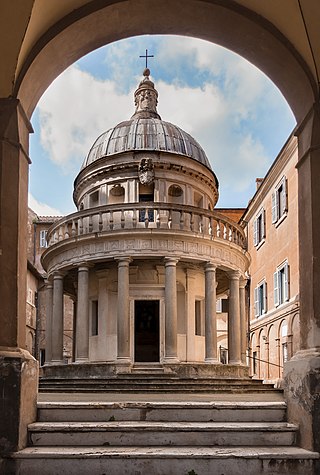
Renaissance architecture is the European architecture of the period between the early 15th and early 16th centuries in different regions, demonstrating a conscious revival and development of certain elements of ancient Greek and Roman thought and material culture. Stylistically, Renaissance architecture followed Gothic architecture and was succeeded by Baroque architecture and neoclassical architecture. Developed first in Florence, with Filippo Brunelleschi as one of its innovators, the Renaissance style quickly spread to other Italian cities. The style was carried to other parts of Europe at different dates and with varying degrees of impact.
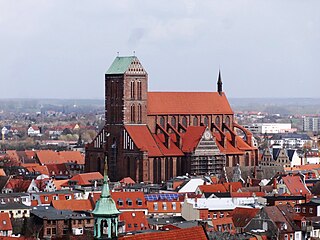
Wismar, officially the Hanseatic City of Wismar is, with around 43,000 inhabitants, the sixth-largest city of the northeastern German state of Mecklenburg-Vorpommern, and the fourth-largest city of Mecklenburg after Rostock, Schwerin and Neubrandenburg. The city was the third-largest port city in former East Germany after Rostock and Stralsund.

Konin is a city in central Poland, on the Warta River. It is the capital of Konin County and is located within the Greater Poland Voivodeship. Prior to 1999, it was the capital of the Konin Voivodeship. In 2021 the population of the city was 71,427, making it the fourth-largest city in Greater Poland after Poznań, Kalisz and Piła.

St. Mary's Church is a Roman Catholic church and co-cathedral located in central Gdańsk, Poland. Completed in 1502 in the Brick Gothic architectural style, it is one of the world's largest brick churches and among the city's most important landmarks, known to its inhabitants as the Crown of Gdańsk. Together with Oliwa Cathedral, it serves the Archdiocese of Gdańsk.

Schwerin Castle is a 19th-century Schloss built in the historicist style located in the city of Schwerin, the capital of Mecklenburg-Vorpommern state, Germany. It is situated on an island in the city's main lake, Lake Schwerin.
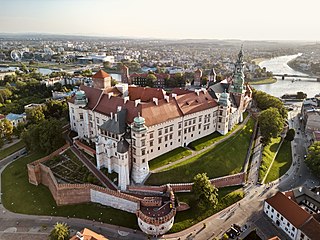
The Wawel Royal Castle and the Wawel Hill on which it sits constitute the most historically and culturally significant site in Poland. A fortified residency on the Vistula River in Kraków, it was established on the orders of King Casimir III the Great and enlarged over the centuries into a number of structures around an Italian-styled courtyard. It represents nearly all European architectural styles of the Medieval, Renaissance and Baroque periods.

The German Renaissance, part of the Northern Renaissance, was a cultural and artistic movement that spread among German thinkers in the 15th and 16th centuries, which developed from the Italian Renaissance. Many areas of the arts and sciences were influenced, notably by the spread of Renaissance humanism to the various German states and principalities. There were many advances made in the fields of architecture, the arts, and the sciences. Germany produced two developments that were to dominate the 16th century all over Europe: printing and the Protestant Reformation.

Brick Gothic is a specific style of Gothic architecture common in Northeast and Central Europe especially in the regions in and around the Baltic Sea, which do not have resources of standing rock. The buildings are essentially built using bricks. Buildings classified as Brick Gothic are found in Belgium, Netherlands, Germany, Poland, Lithuania, Latvia, Estonia, Kaliningrad, Switzerland, Denmark, Sweden and Finland.

The Renaissance in Poland lasted from the late 15th to the late 16th century and is widely considered to have been the Golden Age of Polish culture. Ruled by the Jagiellonian dynasty, the Crown of the Kingdom of Poland actively participated in the broad European Renaissance. The multinational Polish state experienced a period of cultural growth thanks in part to a century without major wars, aside from conflicts in the sparsely-populated eastern and southern borderlands. The Reformation spread peacefully throughout the country, and living conditions improved, cities grew, and exports of agricultural products enriched the population, especially the nobility (szlachta), who gained dominance in the new political system of Golden Liberty.

The Ducal Castle, also known as the Pomeranian Dukes' Castle, and Szczecin Castle, is a renaissance castle in the city of Szczecin, Poland, located at the Castle Hill in the Stare Miasto neighbourhood, near the Oder river. It is built in the gothic and Pomeranian mannerism architectural style. The castle was the seat of the dukes of Pomerania-Stettin of the House of Pomerania, who ruled the Duchy of Pomerania from 1121 to 1637. The building history originates in 1346, when Duke Barnim III began the construction of the ducal housing complex, and continues to 1428, when, under the rule of Casimir V, it was expanded, forming the castle. Currently, it is one of the largest cultural centres in the West Pomeranian Voivodeship, Poland.
Renaissance architecture was that style of architecture which evolved firstly in Florence and then Rome and other parts of Italy as the result of Renaissance humanism and a revived interest in Classical architecture. It was part of the general movement known as the Italian Renaissance, which spread outwards from Italy and effected many aspects of scholarship and the arts. When the Renaissance spirit was exported into Eastern Europe, it had to compromise with local traditions and climates. The Renaissance style differs from place to place throughout the region with many local characteristics making themselves apparent.

The architecture of Germany has a long, rich and diverse history. Every major European style from Roman to Postmodern is represented, including renowned examples of Carolingian, Romanesque, Gothic, Renaissance, Baroque, Classical, Modern and International Style architecture.
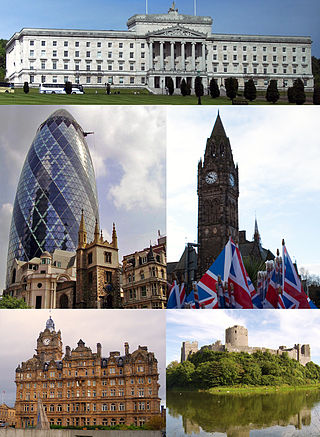
The architecture of the United Kingdom, or British architecture, consists of a combination of architectural styles, dating as far back to Roman architecture, to the present day 21st century contemporary. England has seen the most influential developments, though Ireland, Scotland, and Wales have each fostered unique styles and played leading roles in the international history of architecture. Although there are prehistoric and classical structures in the United Kingdom, British architectural history effectively begins with the first Anglo-Saxon Christian churches, built soon after Augustine of Canterbury arrived in Great Britain in 597. Norman architecture was built on a vast scale throughout Great Britain and Ireland from the 11th century onwards in the form of castles and churches to help impose Norman authority upon their dominions. English Gothic architecture, which flourished between 1180 until around 1520, was initially imported from France, but quickly developed its own unique qualities.

Mannerist architecture and sculpture in Poland dominated between 1550 and 1650, when it was finally replaced with baroque. The style includes various mannerist traditions, which are closely related with ethnic and religious diversity of the country, as well as with its economic and political situation at that time. The mannerist complex of Kalwaria Zebrzydowska and mannerist City of Zamość are UNESCO World Heritage Sites.
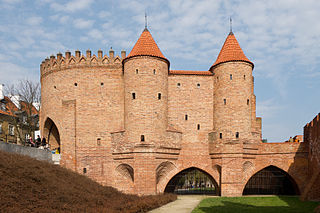
The architecture of Warsaw has influenced and reflected the history of Polish architecture. The city of Warsaw features prominent buildings in a variety of styles by many important architects. Warsaw's palaces, churches and mansions display a richness of color and architectural details.

Franciscus Pahr was an Italian architect who worked in Silesia and Sweden from the 1550s. He is remembered above all for his work in Uppsala where he contributed to the cathedral and castle. He refurbished the Upsala castle completely after the fire of 1572. Pahr was from a family of architects who worked in Germany and Sweden during the later part of 16th century and were instrumental in introducing Renaissance architecture to northern Europe. One of the first projects in this genre in Germany was Pahr's work at Uppsala.

Gothic architecture is a style of architecture that flourished during the high and late medieval period. It evolved from Romanesque architecture and was succeeded by Renaissance architecture.

Belarusian Gothic, also known as Ruthenian Gothic, is the architectural style of ecclesiastical buildings and fortified structures of the 15th and 16th centuries in modern Belarus, Lithuania, eastern Poland and western Ukraine.